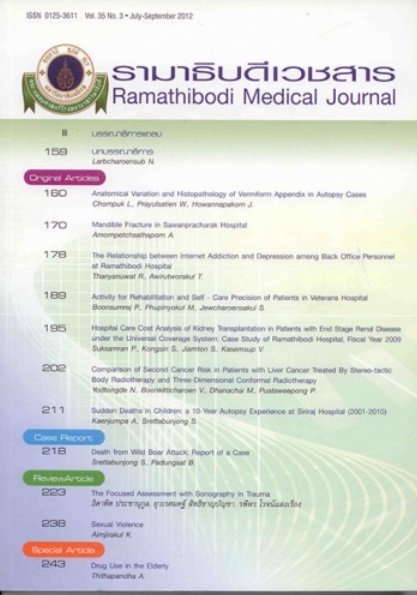Sexual Violence
Main Article Content
Abstract
Sexual violence is both a profound public health problem and human rights violation, while the short and long-term consequences of it limit the potential of victims/ survivors to achieve an optimum standard of health and well-being. There are many important physical consequences of sexual violence. Pregnancy may occur in the absence of contraception and is particularly stressful if termination is not an option. Sexually transmitted infections (STIs) may be acquired and, if untreated, can result in infertility, chronic pelvic pain, and pelvic inflammatory disease. In high-prevalence setting, the transmission of HIV during sexual assault is a major concern for victims/ survivors. Genital and other injuries may also occur in the course of sexual violence. Thus all victims need treatment for possible STIs, and in all but the lowest prevalence setting prophylaxis against HIV is also need. Injuries sustained may require treatment and psychological support is also of great importance.
Article Details
References
Tjaden PG, Thoennes N. Extent, Nature, and Consequences of Rape Victimization:
Findings From the National Violence Against Women Survey. U.S. Department of Justice,
Office of Justice Programs National Institute of Justice; 2006. https://www.ncjrs.gov/pdffiles1/nij/210346.pdf.
United Nations’ Committee on the Rights of the Child. Thailand NGO Report on The
Implementation of the Convention on the Rights of the Child 2000 – 2004. Bangkok: National Council for Child and Youth Development (NCYD), Center for the Protection of Children’s Rights (CPCR) and child and youth development NGOs and youth groups; 2005.
Teerapong S , Lumbiganon P, Limpongsanurak S, Udomprasertgul V. Physical health consequences of sexual assault victims. J Med Assoc Thai. 2009;92(7):885-90.
Workowski KA, Berman S; Centers for Disease Control and Prevention (CDC). Sexually transmitted diseases treatment guidelines, 2010. MMWR Recomm Rep. 2010;59(RR-12):1-110.
Trussell J, Rodríguez G, Ellertson C. New estimates of the effectiveness of the Yuzpe regimen of emergency contraception. Contraception. 1998;57(6):363-9. doi:10.1016/S0010-7824(98)00042-0.
Glasier A. Emergency postcoital contraception. N Engl J Med. 1997;337(15):1058-64. doi:10.1056/NEJM199710093371507.
Gostin LO, Lazzarini Z, Alexander D, Brandt AM, Mayer KH, Silverman DC. HIV testing, counseling, and prophylaxis after sexual assault. JAMA. 1994;271(18):1436-44. doi:10.1001/jama.1994.03510420068036.
Smith DK, Grohskopf LA, Black RJ, Auerbach JD, Veronese F, Struble KA, et al. Antiretroviral postexposure prophylaxis after sexual, injection-drug use, or other nonoccupational exposure to HIV in the United States: recommendations from the U.S. Department of Health and Human Services. MMWR Recomm Rep. 2005;54(RR-2):8-14.
